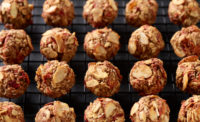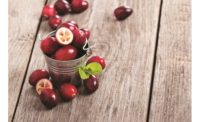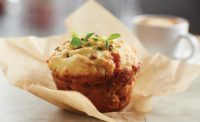The idea of “better for you” encompasses much of what consumers desire today in many of their snacks and baked goods: clean label, non-GMO, natural and—at its core—solid nutrition to make those foods a healthy part of their daily diet.
But the details are often a moving target. “According to Technomic,” notes Mary LaGuardia, marketing manager, Dow AgroSciences, Indianapolis, “51 percent of consumers 18–34 say their definition of health has changed in the past two years.”
A holistic approach
Every aspect of the food matrix must come under scrutiny. “Fats and oils are 20-30 percent of a typical baked good or fried snack, so if we can improve the nutrition of the oil in snack foods, we can help consumers meet their health goals,” says LaGuardia. Dow AgroSciences has used its plant science expertise to breed a better sunflower seed oil profile. “When it becomes commercially available, Omega-9 Sunflower Oil will have the first saturated-fat-free label claim, along with the highest levels of heart-healthy monounsaturated fats among cooking oils.”
Ricardo Rodriguez, marketing manager, Ingredion, Bridgewater, NJ, admits that it’s hard to interpret what exactly is meant by “better-for-you” food, and this has led to a lot of confusion among consumers. “We know that our customers are asking us for simpler ingredient solutions, such as alternatives to complicated ingredient labels.”
Rodriguez also noted that the 2017 “Food & Health Survey” by the International Food Information Council (IFIC) asked consumers how they defined a healthy food, and nearly 60 percent responded “high in healthy components and nutrients.”
In a study conducted by Ingredion, 79 percent of consumers found it important to recognize product ingredients, and 67 percent found it important to have a short, simple ingredient list, notes Rodriguez.
These demands pose challenges. “There are definitely technical challenges that arise when manufacturers look to clean up their labels and remove a variety of traditional ingredients,” says David Guilfoyle, group manager, DuPont Nutrition & Health, St. Louis. “Not all clean solutions are the same, nor should they be, so identifying the right partner with the right tools and the right expertise to navigate this trend is crucial.”
Clean-label or not, a product must perform to expectations. “Clean-label products must be able to demonstrate performance that matches or exceeds traditional ingredients,” says Matt Patrick, head of research, development and technical services, Delavau Food Partners, Philadelphia. “Our Encore line of products yield bread, doughnuts, rolls and other baked goods that look and taste as good—or better—than their conventional counterparts.”
Guilfoyle notes that enzyme systems can go a long way toward achieving better-for-you goals: “We have a wide range of enzymes that address softening, strengthening and dough conditioning. Enzymes are an excellent way to address clean label, but often need other ingredients to address all the functionality required in today’s products. DuPont also offers lecithin, antioxidants and antimicrobial options that can be well received among those looking to address clean label.”
Organic is also on the rise. Solvaira Specialties, Tonawanda, NY, has developed a certified-organic batch pack blend for tortillas, notes Colleen Was, sales coordinator.
Nutritional, clean-label snacks and baked goods also often need help when it comes to extending shelf life. A&B Ingredients, Fairfield, NJ, introduced CytoGuard CDP for just this purpose, notes Joe O’Neill, VP sales and development. CytoGuard CDP is a natural, clean-label shelf-life protection ingredient based on fermented dextrose. “CytoGuard CDP is specifically designed as an extremely cost-effective mold inhibitor and shelf-life extender, primarily focused to prevent mold in low-moisture systems,” he says. “However, it is also effective as part of a natural shelf-life solution for higher-moisture food products.”
Going with the grain
“From our experience, fiber-fortified, protein-enriched and reduced-calorie foods are high on the list of applications and product formats related to the better-for-you trend,” says Steve Pickman, public relations manager at MGP Ingredients, Atchison, KS.
“At the 2017 IFT, we launched our clean label Arise 8100 and Arise 8200 wheat protein isolates,” says Ody Maningat, Ph.D., vice president of R&D and chief science officer, MGP. “These two products are Non-GMO Project Verified and do not contain sulfites.” They also help decrease dough mixing time and improve handling. “One of the functions these two ingredients provide is the total replacement in bread products of DATEM and SSL.”
Whole and ancient grains can add significant nutrition to snacks and baked goods. Zachery Sanders, director of marketing, Ardent Mills, Denver, suggests popped or flaked quinoa, barley or even sorghum to boost nutrition in anything from trail mixes to snack crackers. “These grains offer fiber, which when combined with protein, can complement one another in terms of digestion. Our new Nature’s Color Barley line is another means to deliver not only whole-grain nutrition, but unique color and flavor to snack bars and other baked goods.” It’s available in three color varieties, Black Jack, True Blue and Pure Purple, and in seed, flour and flake forms. It also maintains a clean ingredient statement.
Protein power
According to Orlaigh Matthews, strategic marketing manager, Kerry, Beloit, WI, the plant protein market is growing quickly and expected to continue to grow, with a projected value of $14 billion by 2022 (Mordor Intelligence, 2017). She attributes the growth to four consumer drivers: growing interest in health and wellness, a rise in food allergies and intolerances, concern over sustainability, and a growing demand for clean-label solutions.
“Pea protein is one of the hottest ingredients,” says Chris Quevedo, senior product manager, Batory Foods, Des Plaines, IL—but managing flavor can be an issue. “The pea protein we carry has one of the cleanest flavor profiles.” That means a decreased need for masking.
“Pulses add the nutritional benefits of protein and fiber that address the consumer need for protein and fiber-rich, clean-label products,” says Rodriguez. “Ingredion offers a range of pulse-based ingredients, including peas, lentils, fava beans and chickpeas. Just launched this year are PRECISA Crisps, a series of snack texturizers. These allow manufacturer to create baked snacks with enhanced textures, optimal expansion and reduced breakage.” The line offers a range of textures.
“It can be a struggle to get a formula that meets a customer’s protein goal yet delivers on critical functional benefits,” says Bill Gilbert, principal food technologist, Cargill, Minneapolis. “For example, proteins tend to hydrate and compete for water, increasing the bulk density of puffed cereals, snacks and baked products. All proteins have different water-absorption rates, and we have done extensive testing with a wide range of protein types and blends. We’ve learned how to keep the rheology the same so that formulators don’t have to dramatically change the amount of water in their formula.”
Although coconut and almond flours help create grain-free, high-protein foods, a 1:1 replacement will not always yield a desirable texture. These alternative flours can be tricky to work with, as neither has much binding power, notes Nesha Zalesny, technical sales manager, Fiberstar, Inc., River Falls, WI. “Baked goods with these ingredients tend to shatter after baking, or the products dry out quickly.” Citri-Fi natural citrus fiber can improve texture and quality. “Due to this natural fiber’s high water-holding power, products using non-traditional flours retain moisture, which improves the quality over the shelf life of the product.”
Another ingredient gaining traction is rice protein. According to David Janow, CEO and president, Axiom Foods, Los Angeles, a double-blind study found that rice protein is as effective for building and maintaining muscle as animal-based whey protein. The company’s Oryzatein brown rice protein is extracted using a natural, non-hexane process. “Oryzatein meets the most-stringent quality guidelines from how it’s sourced and naturally manufactured to multi-level testing to ensure safety,” he says. It’s also allergen-free.
Since proteins vary in amino acid content, FDA has adopted the protein digestibility-corrected amino acid score system (PDCAAS) to compare, among other factors, essential amino acid content, on a scale from 0 to 1. Kerry has developed ProDiem, an optimized blend of pea, rice and oat protein, to have a perfect PDCAAS score of 1. The line is intended for use in bars and baked goods, among other applications, notes Matthews. “We also use a proprietary processing technique and our flavor masking technology to improve the texture and reduce the off-notes traditionally associated with plant proteins.”
Completing the nutritional puzzle
The U.S. consumer is now more aware of probiotics as a functional ingredient. Michael Bush, president and CEO, Ganeden, Mayfield Heights, OH, sees consumers wanting to take a proactive versus reactive approach to health, with a larger focus on the health of the products and ingredients they are consuming. “Functional snack and bakery items allow consumers to get the health benefits they’re looking for in products they consume daily, even when on the go,” he says.
As most formulators know, the survivability of probiotics in certain applications presents a challenge. Bush explains that Ganeden has introduced GanedenBC30, a patented, spore-forming probiotic that is shelf stable and can be used in snacks and baked goods. “The fortification of snacks and bakery products is only possible due to the development of shelf-stable strains like GanedenBC30, which are able to withstand manufacturing processes, shelf life and gastric transit. These newer, patented strains have opened up endless opportunities for probiotics.”
Many consumers are also increasingly aware of the sugar content of their foods. In the 2017 IFIC “Food & Health Survey,” 76 percent of survey respondents said they were trying to limit or avoid sugars in general, notes Pam Stauffer, global marketing programs manager, Cargill. “The new label changes to the Nutrition Facts panels will put calories in larger, bold font and call out added sugar content.”
To meet reduced-sugar demands, Cargill offers ViaTech stevia, as well as Zerose erythritol. “Erythritol is a natural, zero-calorie bulk sweetener that looks and tastes like sugar,” says Stauffer. “It masks the aftertaste of high-intensity sweeteners and offers significant advantages over other polyols, including a higher digestive tolerance. Our team has had success in reducing sugar up to 50 percent in cookies, cereals and sweet snacks by using ViaTech stevia and Zerose erythritol.”
We’ve reached the point where truly nutritional, better-for-you, clean-label foods are a primary pathway toward relevance with consumers. People will continue to “want it all,” and with the help of some clever nutritional and functional ingredients, the industry can continue to deliver.








